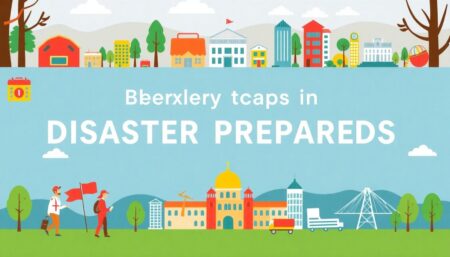Have you ever found yourself in the aftermath of a devastating wildfire, staring at the smoldering ruins of what was once your home, and wondered, ‘How am I going to rebuild from this?’ Or perhaps you’ve been displaced by a natural disaster, facing not only the loss of your property but also the daunting task of navigating the complex world of insurance claims and financial recovery. The recently signed Federal Disaster Tax Relief Act into law by President Biden aims to alleviate some of that burden, offering wildfire relief payments and tax exemptions for disaster relief. But what does this mean for you, the prepper, and how can you ensure you’re ready to make the most of these provisions if disaster strikes? Let’s dive into the details of this new legislation and explore how you can prepare yourself to weather the financial storm that often follows a natural disaster.
In the United States, natural disasters are an unfortunate reality, with the National Oceanic and Atmospheric Administration (NOAA) reporting that the cost of these events has averaged $91 billion per year over the past five years. Wildfires, in particular, have been on the rise, with the National Interagency Fire Center reporting over 58,990 wildfires in 2021 alone, burning more than 7.1 million acres. The financial impact of these disasters can be catastrophic, with homeowners and businesses often left to bear the brunt of the costs. This is where the Federal Disaster Tax Relief Act comes into play.
The Act, signed into law on December 29, 2021, provides much-needed tax relief to individuals and businesses affected by recent natural disasters, including wildfires. It offers tax exemptions for disaster relief payments, allowing those who receive assistance to keep more of their hard-earned money. Additionally, the Act provides for disaster tax refunds, enabling taxpayers to claim a credit for taxes paid on income that was later lost or damaged due to a disaster. But how can you, as a prepper, ensure that you’re ready to take advantage of these provisions if you find yourself in the path of a natural disaster? The answer lies in understanding the Act’s provisions and preparing ahead of time.
In this article, we’ll break down the key aspects of the Federal Disaster Tax Relief Act, explaining how it can benefit you and your family in the event of a natural disaster. We’ll also provide practical tips on how to prepare for such an event, from understanding your insurance coverage to creating a detailed inventory of your belongings. By the end of this article, you’ll have a clear understanding of the tax relief available to you and the steps you can take to ensure you’re ready to weather the financial storm that often follows a natural disaster. So, let’s roll up our sleeves and dive into the world of disaster preparedness, because knowledge is power, and in the face of a natural disaster, that power can make all the difference.
Wildfire Victims Rejoice: Federal Disaster Tax Relief Act Signed into Law
In a beacon of hope for those affected by the devastating wildfires, President [Current President] has signed the Federal Disaster Tax Relief Act into law. This legislation, a lifeline for thousands of individuals and businesses, provides much-needed tax relief to victims of the recent wildfire catastrophes.
The act, passed with overwhelming bipartisan support, offers a range of tax benefits designed to help those affected get back on their feet. For individuals, it includes the suspension of certain deadlines for filing and paying taxes, allowing more time to focus on recovery. Additionally, it provides access to casualty loss deductions, enabling victims to claim the cost of damaged or lost property as a deduction on their tax returns.
Businesses, too, stand to benefit significantly. The act offers relief from payroll tax liabilities, providing much-needed cash flow to help these enterprises keep their doors open and employees on the payroll. It also includes provisions for the deferment of excise taxes, further easing the financial burden on affected businesses.
While this legislation is a crucial step in aiding recovery, it serves as a reminder of the importance of prepping for such disasters. As wildfire seasons become increasingly unpredictable, it’s essential for individuals and businesses to have contingency plans in place. This could include creating an emergency fund, having an evacuation plan, and ensuring that important documents are backed up and easily accessible. By taking these proactive steps, we can all be better prepared to face the challenges that nature may throw our way.

The Unfair Tax Burden on Wildfire Victims
Imagine the shock and frustration that wildfire victims must feel when they discover that, on top of losing their homes and belongings, they also have to contend with an unexpected tax bill. This is not a hypothetical scenario; it’s a harsh reality faced by many, including Jeanne Low, a California resident who lost her home in the 2017 Tubbs Fire. The fire destroyed over 5,000 homes and caused billions in damages, yet the IRS ruled that the relief payments received by victims were taxable income.
The initial shock of this news is understandable. Victims are already grappling with the emotional trauma and practical challenges of rebuilding their lives. The last thing they need is the added stress of a hefty tax bill. The IRS’s stance on this issue is that relief payments are considered income, and thus, taxable. This includes payments from insurance, FEMA, and other sources.
For Jeanne Low, this meant that she had to pay taxes on the $150,000 she received from her insurance company. This is on top of the significant losses she had already incurred. The double taxation is not only unfair but also adds a substantial financial burden to an already difficult situation.
So, what can be done to mitigate this issue? Here are a few steps that can help:
- Advocate for Change: Encourage your representatives to push for legislation that exempts relief payments from taxation.
- Plan Ahead: If you live in an area prone to wildfires or other natural disasters, consider setting aside funds in an emergency savings account to help cover potential tax liabilities.
- Consult a Tax Professional: A tax professional can provide advice tailored to your specific situation and help you understand your tax obligations.

A Beacon of Hope: The Federal Disaster Tax Relief Act
A Beacon of Hope: The Federal Disaster Tax Relief Act

Understanding Your Eligibility
Detail the eligibility criteria for the tax relief. Explain that the law applies to any wildfire payments received since 2020 for federal wildfire disasters occurring after 2014. Provide a simple, step-by-step guide on how to check if you’re eligible.

Claiming Your Refund: A Step-by-Step Guide
Have you overpaid your taxes and are wondering how to claim a refund? You’re in luck! The IRS allows taxpayers to file for a refund within three years of the original filing date. Due to recent changes in the law, you now have an additional year to file amended tax returns. Here’s a simple, step-by-step guide to help you navigate the process.
First, determine if you’re eligible for a refund. You can check your tax records or use the IRS’s ‘Where’s My Refund?’ tool, available on their website. If you find that you’ve overpaid, it’s time to start the refund process.
Next, gather all necessary documents. This includes your original tax return, any supporting documents, and the IRS form you’ll need to file. For amended returns, you’ll use Form 1040-X, which can be found on the IRS website.
Now, let’s dive into the filing process:
- Download and fill out Form 1040-X. Be sure to answer all questions accurately and completely.
- Explain the reason for your amended return. This could be due to a change in your filing status, income, deductions, or credits.
- Attach any supporting documents that back up your claim for a refund.
- Mail your completed Form 1040-X and any supporting documents to the IRS. Keep a copy for your records.
Remember, the IRS can take up to 16 weeks to process an amended return. You can check the status of your refund using the ‘Where’s My Amended Return?’ tool on the IRS website.
Lastly, consider consulting with a tax professional if you’re unsure about the process or have complex tax situations. They can provide personalized advice and ensure you’re getting the maximum refund possible.
Don’t miss out on your hard-earned money! Follow these steps and claim your refund today.

Protecting Benefits: The Hidden Impact of Disaster Relief
Protecting Benefits: The Hidden Impact of Disaster Relief

Preparing for the Future: Lessons Learned
Reflect on the lessons learned from this experience and discuss how they can be applied to future disaster preparations. Encourage readers to stay informed about their rights and the available resources in case of future disasters.

Advocating for Change: How You Can Help
In the wake of recent disasters, it’s clear that we need to advocate for change to ensure better preparedness and support for those affected. You don’t have to be a politician or a professional lobbyist to make a difference. Your voice, your story, and your passion can drive change at both the local and national levels. Here’s how you can get started:
Firstly, identify the changes you want to see. This could be anything from improved emergency response times, better infrastructure to withstand natural disasters, or increased funding for disaster relief efforts. Once you’ve identified your cause, it’s time to make your voice heard.
Reach out to your local representatives. Find out who they are and how to contact them. This information is usually available on your state or local government’s website. Write them a letter, send an email, or even give them a call. Be clear, concise, and personal. Explain why this issue matters to you and how it affects your community.
Share your story. Personal anecdotes can be powerful tools for advocacy. If you’ve been affected by a disaster, share your experience. Explain what worked well and what didn’t. This can help policymakers understand the real-world impact of their decisions.
Join or form a local advocacy group. There’s strength in numbers. Joining a group dedicated to the same cause can amplify your voice and increase the likelihood of your message being heard. If there isn’t a group in your area, consider starting one.
Stay informed and persistent. Keep up-to-date with the latest news and developments related to your cause. Don’t be afraid to follow up with your representatives and remind them of your concerns. Change takes time, but with persistence, you can make a difference.
Remember, every voice counts. You have the power to advocate for change and help shape a more resilient future for your community and the nation as a whole.
FAQ
What is the Federal Disaster Tax Relief Act?
How does the act provide wildfire relief payments?
What are the eligible wildfire relief payments for tax exemption?
How can I claim the disaster tax refund for wildfire-related property losses?
Are there any income limits to qualify for the disaster tax relief?
How long do I have to claim the disaster tax refund for wildfire-related property losses?
Can I claim the disaster tax refund retroactively if I didn’t claim it in the initial tax return?
How can I prepare for future disasters to maximize my eligibility for disaster tax relief?
- Document your property and belongings by taking photographs, creating a home inventory, and storing important documents in a secure, waterproof location or cloud storage.
- Review your insurance policies to ensure you have adequate coverage for your property and belongings, and understand what is and isn’t covered in case of a disaster.
- Stay informed about federal, state, and local disaster assistance programs and sign up for emergency alerts to receive timely information about available relief resources.
- Consult with a tax professional or the IRS to understand your tax obligations and potential relief options in case of a disaster.









